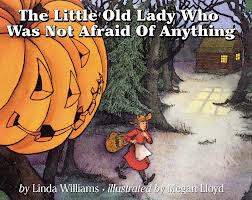I have seen a few other posts about this book lately, (check out these posts by Playing With Words 365 and Chapel Hill Snippets to start) so I wasn't going to write about this one, but it really is the book I'm using this week! "The Little Old Lady Who Was Not Afraid of Anything
If you're not familiar with the story, it's about a little old lady who ventures out into the woods to gather some herbs, nuts, and seeds. She's gone so long it starts to get dark. On her way home she meets two shoes that go "Clomp! Clomp!," one pair of pants that go "Wiggle! Wiggle!," one shirt that goes "Shake! Shake!," two gloves that go "Clap! Clap!," one hat that goes "Nod! Nod!," and one scary pumpkin head that goes "Boo! Boo!" Even though she's not afraid of anything, she runs home and locks the door behind her. She hears a knock and the pumpkin head tells her that they came to scare her. She tells them that they cannot scare her...they get together to make a scarecrow.
My take on it:
Again, I know these ideas may not be new and/or innovative. But, here goes:
I use this book as an in-class lesson. I start out by telling the students the title of the story. I ask each student if they have anything that they're afraid of. Usually the answer to that is "no," until they hear another child say something that scares them. I then draw their attention to the "L" in "Little" and "Lady." We talk about the letter and it's sound and brainstorm other words that start with "L" (artic practice for my kiddos working on /l/).
BTW, I tell the kids I'm afraid of snakes and spiders (Hello, /s/ blends!)...
I read the story with story props that I printed from Toddler Approved. I colored and laminated the props, then attached velcro so I can put them together to form the scarecrow at the end of the story.
I lay the props out on the floor in front of me as they appear in the story. I have the children repeat each sound with an accompanying movement (e.g., stomping their feet for the "Clomp! Clomp!"). As we're reading the story, I touch each prop as we do the sound/movement. When we get to the end where the little old lady goes to sleep, I ask the kids to close their eyes and pretend to sleep. While they're doing this, I put the scarecrow together using the props and hide it behind my back. When they're "awake," the props are gone and the students no longer have the visuals to sequence the order of the items for the last go-through of all the items. I usually start them out with "She saw two shoes that go..." then see how much they can remember of the order and accompanying sound/movement. On the last page, I bring out the completed scarecrow!
 |
| Toddler Approved shows the items taped to a wall |
After we read the story, we use puppets that I made by printing the felt board pieces from Making Learning Fun onto card stock, laminating, and attaching to popsicle sticks. I made a couple of sets of these because some classes have more than 6 kids. I hand out one part to each child. I pay attention to the child's speech and language goals when I've giving out the puppets. For example, if I have a child working on /sh/, I give that child the shirt puppet. I play the Old Lady. We then act out the story and I ask "WH" questions along the way. I start out saying something like "One day, I went for a long walk in the woods. Now, I know I came out here for a reason...Hmm, why am I out in the woods? (to pick nuts and seeds) Oh, right!" As I "meet" the clothing items along the way, the children follow me around the room until we have a little parade going. They love this part!
 |
| felt board pieces from Making Learning Fun |
When we're done with our "play," we review the items and their noises and review any articulation target words.
I have used this book in small group settings with older students as well. After the story, we typically play the Clothes Match Fun Game from Making Learning Fun.
 |
| Clothes Match Fun Game |
What's your take on "The Little Old Lady Who Was Not Afraid of Anything"?



